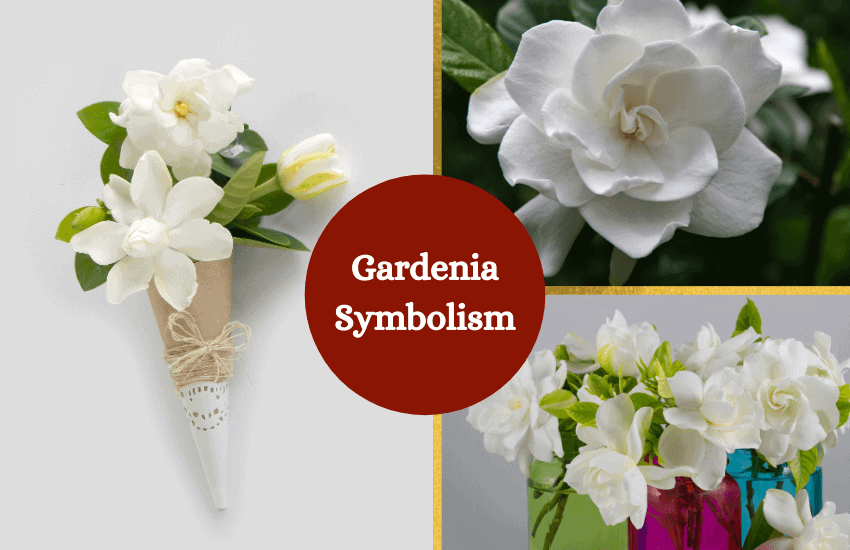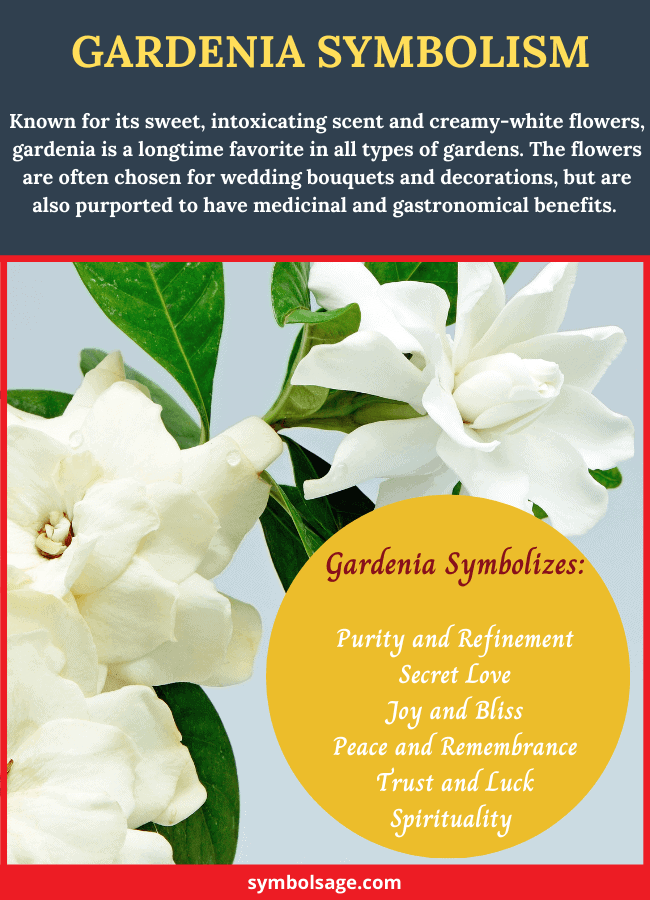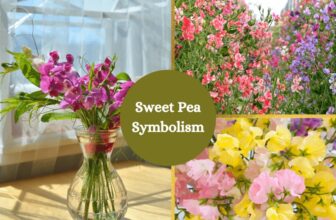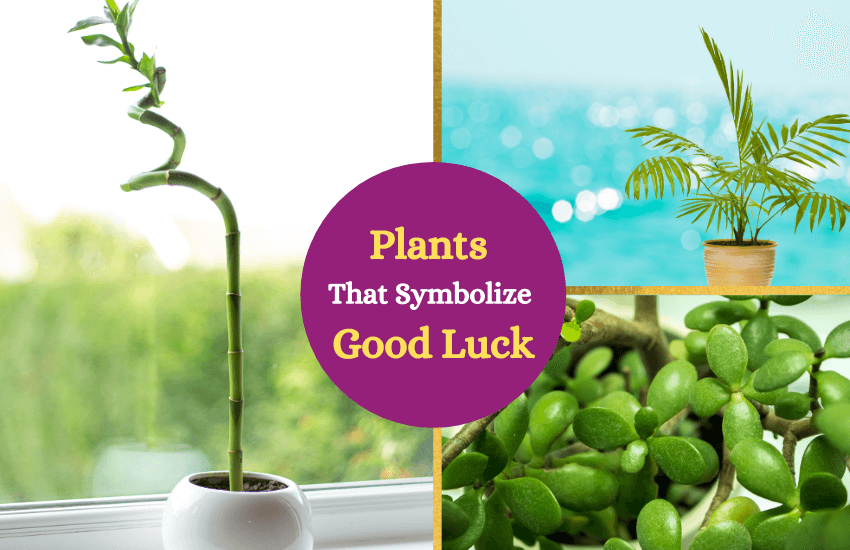
Table of Contents
Known for its sweet, intoxicating scent and creamy-white flowers, gardenia is a longtime favorite in all types of gardens. Here’s a look at why it’s loved by brides around the world, along with its significance and practical uses today.
About the Gardenia Flower
Gardenia is the genus of tropical evergreens that belong to the Rubiaceae family. While most of its shrub and tree species are native to Africa and Pacific islands, the Gardenia jasminoides, also called Gardenia augusta or cape jasmine, is native to China.
If you’re wondering why the flower is called gardenia, it’s in honor of Alexander Garden, a popular and highly respected botanist who created the method of genus/species classification that’s still in use.
Blooming from early to late summer, gardenia petals generally have a matte texture, leathery, dark green leaves, and berrylike fruits.
The flower is commonly white, but gradually turns creamy yellow as it matures. Some varieties of gardenia have a yellow tinge at the base.
These flowers are sensitive to the cold and don’t do well in cool temperatures. Due to this, they’re often grown in regions with warm temperate and subtropical climates. Because they grow best in heat and humidity, they can be challenging houseplants for Northern gardeners.
Meaning and Symbolism of Gardenia
Gardenias are rich in symbolism and meaning. Here are some of the associations of the flower.
- Purity and Refinement – Because the color of the flower is white, gardenias represent purity, making them a frequent choice for wedding bouquets. It signifies the purity of love and relationship, as well as the refined beauty of the bride.
- A Secret Love – Gardenias with a little tinge of yellow at its base symbolize love and passion associated with secrecy. During Victorian times, when feelings of the heart weren’t often expressed out loud, gardenias were used to express admiration without revealing one’s identity. If you’re romantic at heart, it’s the silent way to say, “I love you,” as well as “You’re lovely.”
- Joy or Bliss – These blooms are captivating and full of personality, making them the perfect flower for celebrations.
- A Symbol of Peace – Gardenias are often sent to someone to express grief and sympathy and a hope for peace, as well as a sentiment of remembrance.
- In some contexts, they can also symbolize trust, hope, gentleness, and good luck. Some even associate it with spirituality and mystical properties.

Uses of Gardenias Throughout History
Gardenias are a favorite flower grown in Chinese gardens since antiquity, and have been used in medicine, cosmetics, perfumes, and even in magic.
- In Gastronomy
During ancient times, gardenias were used to add fragrance to tea leaves and raw rice. Nowadays, they’re often added to fruit salads, desserts, drinks, and syrups. The white petals can turn brown easily, so lemon juice is often sprinkled on them to keep them fresh.
- In Medicine
Disclaimer
In traditional Chinese medicine, gardenias, including the flower, roots, and berries, are used for treating snakebites. It’s been utilized for making lotions and flower washes, which are thought to relieve sores, sunburns, inflamed skin, rashes, toothache, and insect bites.
In Indonesia, its flowers and leaves are commonly used to make tea, which eases stress, palpitations, abdominal pains, high blood pressure, and fever. Also, the scent of the flower is thought to promote a good night’s sleep and relieve anxiety.
- In Beauty and Fashion
These blooms were used by Japanese empresses as an accessory in their hair, as well as in corsages. Also, in China, it was common to add gardenia flowers to bathwater for softening the skin.
- In the Arts
The cultivation of these blooms dates back to the Song Dynasty, between 960-1279 C.E. In fact, gardenias became a highlight in paintings, as well as a common motif in porcelains, especially of the Yuan and Ming dynasties.
- In Magic and Rituals
Many believe gardenias will fill one’s life with magic and miracles, especially the Gardenia jasminoides. They’re often placed in altars in hopes of bringing luck and prosperity, as well as in healing. Also, floating these blooms in a bowl of fresh water or burning the dried petals as incense is believed to promote peace and spirituality.
Gardenia Flower in Use Today
While gardenias are often grown in greenhouses, cottage, and subtropical gardens, they can be used as ground cover, landscape accents, and shrub borders, as they’ll thrive for many years. Many place them on flowerpots near patios, decks, and windows to enjoy their sweet scent. These flowers can be placed in a bowl of water too, and moved from room to room, to spread its scent.
In weddings, these blooms are often added to bouquets, wedding cakes, hairpiece, wreaths, corsages, boutonnieres, and even floated in water as table accents. Its minimalist beauty and delicate petals make it perfect for a refined occasion. For summer weddings, gardenias are often incorporated with greens, but it’s best to mix it with other colorful flowers in spring.
When to Give Gardenia Flowers
Gardenias can be incorporated into bouquets with other white flowers for a meaningful gift. Gardenia is often given to someone you’re secretly in love with. It’s also a great finishing touch for a moonlit dinner or even a champagne brunch.
Gardenia’s can be a great gift for all occasions, including birthdays, anniversaries, graduations, baptisms, communions, as well as a sympathy gift. The gardenia plant can be gifted as a bonsai, or even placed in baskets, small pots, and wooden boxes to decorate homes and offices.
In Brief
Gardenias are cherished for its sweet scent and pristine beauty, ranking among the favorite of gardens and hedges. As symbol of purity, love, and refinement, the bloom has also earned a reputation as a cherished flower of brides.








